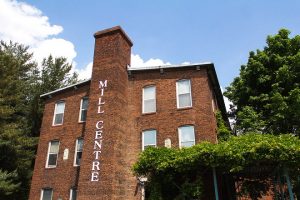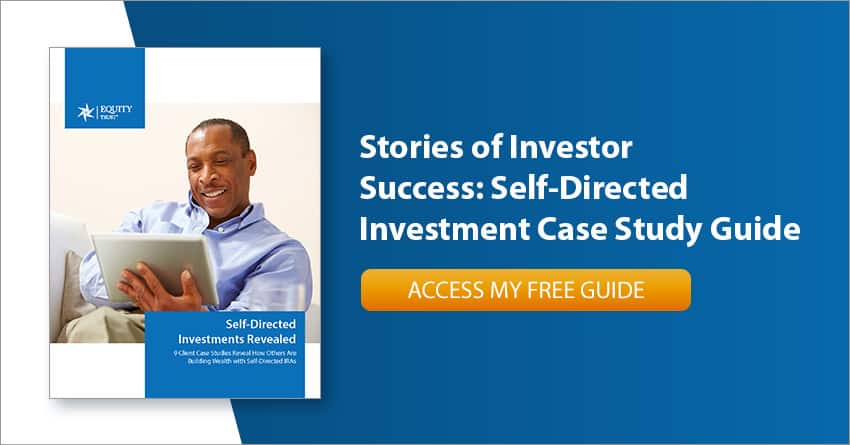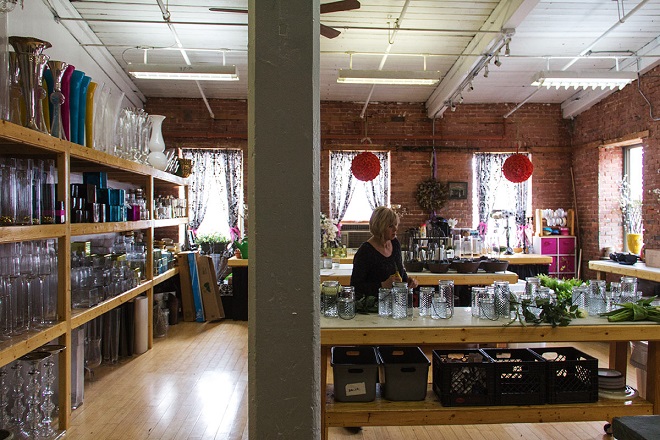Nearly Limitless Options
in One IRA
Invest in both traditional and alternative assets with a single custodian – ready to go beyond a self-directed IRA?
Investor Insights Blog|Investor’s IRA Funds Space for Artists, Entrepreneurs
Real Life Examples

When Larry of Colorado visits family in Baltimore, he swings by a former factory a few miles north of the downtown area. The 100-plus-year-old building is teeming with a new purpose, housing creators, small businesses, and others.

The building is known as The Mill Centre, a mixed-use commercial space. The sturdy, versatile building was originally used to manufacture fabric for sails on 1800s clipper ships. It was rehabbed in the 1980s and adapted for entrepreneurs and businesses of all types, and just recently changed management.
Anchored by a medium-sized software company, the building’s more than 90 other renters include a gym, therapists, graphic designers, artists’ studios and galleries, and photographers. Many of the tenants have formed a tight-knit community.
“They have this culture of walking dogs together,” says Larry. “Apparently there’s a whole group of them. They all bring their dogs to this old building, and at 10 o’clock in the morning this dog pack is going out with all the owners going over to some park. These people just love it.”
Larry feels content knowing that he plays a small part in keeping this creative community running by putting his IRA capital to work.
Long before he began diversifying his retirement savings, Larry was diversifying his marketable skills. In college, he earned dual degrees in forestry and in technical communications/scientific technical writing. When he struggled to find work as a forester, he fell back on his technical communications degree and became a technical writer, later switching his focus to telecommunications and working as a director for DSL (internet connection) product development.
He was then recruited for a financial analyst position at a mutual fund company in California. After 9/11, that business collapsed, so he returned to Colorado and telecommunications.
Larry’s only experience with real estate investing had been as a landlord in the past, and more recently, he bought ranch land from a family trust and is holding it with plans to possibly redevelop it. But none of this had been in an IRA, and he had no other experience with alternative investing. Still, he wanted to try alternatives in his retirement account, for the sake of his financial future.
“I wanted to diversify away from the gambling hall of the stock market,” he says. “To have all of your investments just in stocks and bonds with the volatility we have and crazy things like this Coronavirus – it’s always the perfect storm of what derails us, and nobody sees it coming.”
Larry’s best friend Richard, whom he’d met growing up in New Jersey, was a successful commercial developer on the East Coast. He now works with a partner to find investment opportunities.
Learning his friend wanted to diversify, Richard approached Larry with an investment opportunity in a building that he and his partner had already been invested in: The Mill Centre.
Richard put together a package of 25-30 new investors, which formed an LLC that owns the building.
Richard explained that Larry could use his retirement account – a self-directed IRA – to invest. He consulted with his CPA, who recommended Equity Trust as the self-directed IRA custodian.
Larry owns 3.4 percent of The Mill Centre in his IRA by way of the LLC, a $100,000 investment. After Larry established his Equity Trust IRA and transferred funds from another account, it took a couple of months for the investor group to get the LLC in order.
“It was a challenge because there’s a lot of paperwork, and you have to get a lot of subsidiary documents,” Larry explains, “and then you have to get all these documents associated with the LLC. So, we went through multiple iterations. For part of my career, I worked on federal government contracts with RFPs and stuff; I’d say it was not as challenging as that, but a challenge.”

“It feels good to be investing in a property where a lot of high-energy and creative people interact with each other and have a community.”
Larry, Investor, Colorado
Part of what made the process complex was that there was a large group of investors with various proportions of shares and multiple components required for an LLC, he said, adding the process was a first for many involved and should run more smoothly next time.
From Larry’s standpoint, the process is now automated, so dividends are automatically deposited into his Equity Trust account.
“Once I got it all set up, it’s been running like clockwork,” he says.

Fund managers projected 10-percent returns per year, but Larry’s on track to receive 15-percent cash-on-cash returns. In addition to the monetary return on investment, Larry says there’s nothing like knowing he has an impact on the tenants and the region.
“It feels good to be investing in a property where a lot of high-energy and creative people interact with each other and have a community,” he says. “And it’s also great because you read the statistics about Baltimore and all the jobs they’ve lost over the years. They rebuilt the harbor then they’ve just had political and social problems in Baltimore city; it’s sad.
“But here it is, a bright spot. And I guess there are several other of these hulking old factories that are doing similar things: they’re becoming brewpubs, for example. Just the fact that you’re taking old buildings, recycling them, keeping the history, and providing a place where small businesses can thrive, that feels good.”
The returns are more meaningful when he can see this type of tangible impact, rather than just investing in a nameless fund from a fund manager you don’t know, he adds. “When we go back to visit family, we go to the factory and just walk around, say hello to the tenants. It’s cool.”
Larry’s level of comfort with his first self-directed investment increased after talking through the process with his CPA and Equity Trust associates. His confidence in this specific investment came after he flew to Baltimore to get a first-hand look.
“To me, no investment in the world is any good without people,” Larry says. “And I just loved the people who ran the place. It is just its own culture; very cool. And the people who are on the ground day by day doing operations, have been there 15-20 years. They know that old building and every little creak and sound, so I like the people.”
In addition to his own understanding of financials, Larry trusts his friend who led him to the opportunity. “Richard’s a total straight shooter and has an MBA in addition to three other degrees, so I can talk financials with him and work through the spreadsheets and understand them,” he says. “So that’s a big advantage.”

Some of Larry’s friends had not heard of the concept of a self-directed IRA. He had read about them and considered opening an account in the past, but it was this connection to his friend and the investment that got him fully on board.
For others considering opening an account, Larry recommends they start by talking to their CPA and understanding the ins and outs, as well as taking in education from sources such as Equity Trust.
“Read through that stuff and understand the rules very well first,” Larry says, “and then maybe start picking the brains of people. Maybe (beginners) can get references from their CPA or others who might be willing to talk to them and give them some ideas about how it works. And then they should invest in something that they’re comfortable with, that makes sense to them.”
Seeing the investment in person is an effective way for Larry to vet a potential investment.
“It was obvious the minute I stepped in the door,” he says. “I got the nuance, the feel, I met the people, I saw the crowded parking lot, I got to look at the books. The fact that it wasn’t just some fly-by-night thing, they had ten years of financials and revenue and margins.”
The other factor to consider, Larry says, is that these investments aren’t as liquid as holding mutual funds in an IRA.
“If I want to take a penalty on this one, I’ve got to go begging to the other investors in the LLC and see if they want to buy me out early and if they do, I’m going to take a haircut because they smell blood in the water,” Larry says. “I also have to trust that the investors are looking to enrich themselves by getting appreciation on the property and selling to another group of investors down the road.”
Larry adds, “I need to be quite content just having this $100,000 sitting in there for many years while I’m just building on the dividends. But if you’re expecting just total liquidity and you’re hung up on that, don’t do it.”
Timing and life stage are also important, Larry adds. “At age 72 or 75, this might not have been a smart idea for me because I might need the money for some medical thing that I don’t have today,” he says. “But at age 61 when I got into it, that’s 10 years to run.”
Larry jokes that when he retires, he’ll probably end up working another ten years. He figures he’ll work until he’s 74. If he has to retire early for whatever reason, he’s confident that his investment strategy will leave him plenty of cash in his retirement fund – untouched by COVID or other factors – which he’s counting on for loved ones.
“Some of it is for our four grown children, and some of it is security for my wife, Rita, and myself,” he says. “She’s ten years younger than me. I want to make sure I leave a legacy for her because it’s likely she’s going to outlive me. I want her to have a good life because I love her to pieces.”
In the near term, Larry can’t wait to find more investments like this.
“It’s been one of the most fun investments I’ve ever done,” Larry says, adding, “You can’t downplay to people that you own part of an old clipper ship sail factory that makes 10-11 percent a year that your best friend got you into. The story’s just good.”
Can I roll over a 401(k) account into a self-directed IRA?
Can my IRA purchase real estate that my corporation, partnership or LLC owns?
Case studies are provided for illustrative purposes only. Past performance is not indicative of future results. Investing involves risk including possible loss of principal. Information included in the above case study was provided by the investor and included with permission. Equity Trust Company does not independently verify all information provided by third parties.
You are leaving trustetc.com to enter the ETC Brokerage Services (Member FINRA/SIPC) website (etcbrokerage.com), the registered broker-dealer affiliate of Equity Trust Company. ETC Brokerage Services provides access to brokerage and investment products which ARE NOT FDIC insured. ETC Brokerage does not provide investment advice or recommendations as to any investment. All investments are selected and made solely by self-directed account owners.
Continue